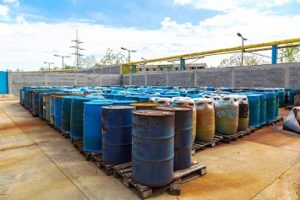Hazardous waste generators will be operating under new rules come the end of May this year. While some of the 60-plus changes are seen as beneficial for the regulated community, there is one provision that has provoked the particular ire of industry groups. We’ll take a look at “conditions for exemption” under the new rules and what happens if you fail to meet a condition of exemption that you have claimed.

annavaczi / iStock / Getty Images Plus / Getty Images
Note: Always check with your state. Many states have stricter and/or additional hazardous waste requirements than the federal.
Groups File Petition for Review
Nine trade associations recently filed a petition with the Court of Appeals for the D.C. Circuit to review the entire Hazardous Waste Generator Improvements Rule, which was published in the Federal Register on November 28, 2016, and takes effect on May 30, 2017, on the federal level. While the petition for review does not cite a particular provision of the new regulation, a review of comments provided by industry generators during the proposal stage reflect a certain amount of disgruntlement with a part of the regulation that provides the penalty for violating a “condition of exemption” for your generator status.
Still Three Classes of Hazardous Waste Generators
While the new regulation still provides for three classes (categories) of hazardous waste generators, one class has been renamed. Under the new hazardous waste generator rule, what used to be called conditionally exempt small quantity generators will soon (as of May 30, 2017) be called very small quantity generators (VSQGs). If you generate hazardous waste, this is the most desirable category of generator to be, because it has the least requirements. The two other classes of generators are still called small quantity generators (SQGs) and large quantity generators (LQGs). The Table shows the categories of hazardous waste generators based on the quantity of waste generated in a calendar month.
Table: Generator Categories Based on Quantity of Waste Generated in a Calendar Month
| Quantity of acute hazardous waste generated | Quantity of nonacute hazardous waste generated | Quantity of residues from a cleanup of acute hazardous waste generated | Generator Category |
| >1 kg | Any amount | Any amount | LQG |
| Any amount | >1,000 kg | Any amount | LQG |
| Any amount | Any amount | >100 kg | LQG |
| <1 kg | >100 kg and <1,000 kg | <100 kg | SQG |
| <1 kg | <100 kg | <100 kg | VSQG |
Note: 1 kilogram (kg) = about 2 pounds (lb)
100 kg = about 220 lb
1,000 kg = about 2,200 lb
Violating Conditions of Exemption
This provision of the new rule found at 40 CFR 262.10(g)(2) is perhaps the most contentious for industry generators. The new rule classifies certain regulations for each generator class as “independent requirements” and certain other regulations as “conditions for exemption” from RCRA permitting and the interim status standards. Conditions for exemption for VSQGs, SQGs, and LQGs are found at 40 CFR 262.14, 40 CFR 262.16 and 40 CFR 262.17, respectively.
According to the new rule, a generator that fails to comply with an “independent requirement” will be subject to enforcement actions concerning the particular requirement. However, a generator that fails to comply with any one of the many conditions of exemption for its class will be considered out of compliance and would default to being an “illegal” treatment, storage, and disposal facility (TSDF) subject to all the TSDF regulations or to the regulations that apply to the next level of generator.
In their comments to the proposed rule, the industry generators argued that all conditions for exemption should be removed, citing the following potential hypothetical situation as a “draconian result” of regulations being considered conditions for exemption: “if a VSQG were to fail to label a drum that it sends to an LQG under common control, the VSQG could be considered not only to have violated that new labeling rule but also to have violated up to the 24 rules that apply to SQGs that do not apply to VSQGs …”
In the preamble to the new rule, the U.S. Environmental Protection Agency (EPA) defended its two classifications of the generator requirements by stating that “these clarifications regarding the distinction between independent generator requirements and the conditions for exemption do not fundamentally alter the way the generator regulatory scheme has operated over the last 30 years.” Clearly many industrial generators do not agree. Stay tuned.
